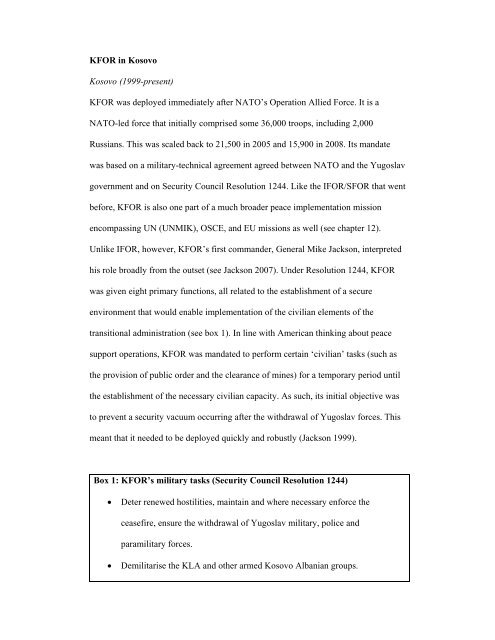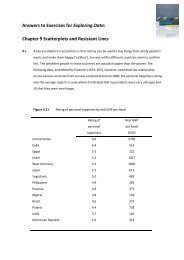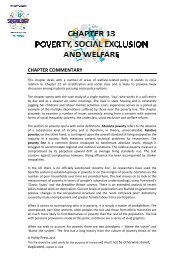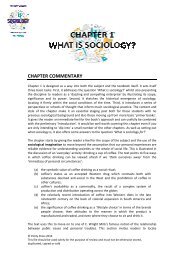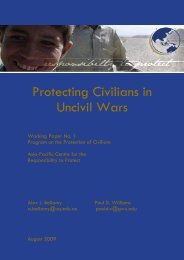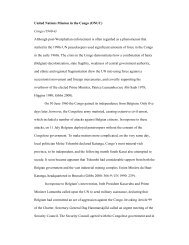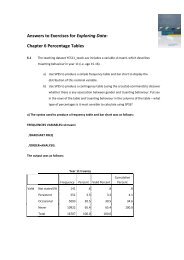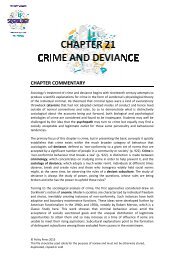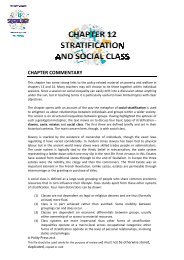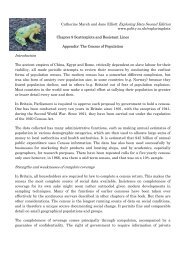KFOR case study - Polity
KFOR case study - Polity
KFOR case study - Polity
You also want an ePaper? Increase the reach of your titles
YUMPU automatically turns print PDFs into web optimized ePapers that Google loves.
<strong>KFOR</strong> in Kosovo<br />
Kosovo (1999-present)<br />
<strong>KFOR</strong> was deployed immediately after NATO’s Operation Allied Force. It is a<br />
NATO-led force that initially comprised some 36,000 troops, including 2,000<br />
Russians. This was scaled back to 21,500 in 2005 and 15,900 in 2008. Its mandate<br />
was based on a military-technical agreement agreed between NATO and the Yugoslav<br />
government and on Security Council Resolution 1244. Like the IFOR/SFOR that went<br />
before, <strong>KFOR</strong> is also one part of a much broader peace implementation mission<br />
encompassing UN (UNMIK), OSCE, and EU missions as well (see chapter 12).<br />
Unlike IFOR, however, <strong>KFOR</strong>’s first commander, General Mike Jackson, interpreted<br />
his role broadly from the outset (see Jackson 2007). Under Resolution 1244, <strong>KFOR</strong><br />
was given eight primary functions, all related to the establishment of a secure<br />
environment that would enable implementation of the civilian elements of the<br />
transitional administration (see box 1). In line with American thinking about peace<br />
support operations, <strong>KFOR</strong> was mandated to perform certain ‘civilian’ tasks (such as<br />
the provision of public order and the clearance of mines) for a temporary period until<br />
the establishment of the necessary civilian capacity. As such, its initial objective was<br />
to prevent a security vacuum occurring after the withdrawal of Yugoslav forces. This<br />
meant that it needed to be deployed quickly and robustly (Jackson 1999).<br />
Box 1: <strong>KFOR</strong>’s military tasks (Security Council Resolution 1244)<br />
• Deter renewed hostilities, maintain and where necessary enforce the<br />
ceasefire, ensure the withdrawal of Yugoslav military, police and<br />
paramilitary forces.<br />
• Demilitarise the KLA and other armed Kosovo Albanian groups.
• Establish a secure environment to enable the return of refugees and displaced<br />
persons, the operation of the transitional administration, and the delivery of<br />
humanitarian aid.<br />
• Ensure public safety and order until the establishment of an international<br />
police presence.<br />
• Supervise de-mining until the establishment of a civilian demining<br />
programme.<br />
• Support and coordinate with the international civilian presence.<br />
• Monitor Kosovo’s borders.<br />
• Protect and ensure the freedom of movement of international military and<br />
civilian personnel.<br />
Source: paraphrased from UN Security Council Resolution 1244 (1999).<br />
In what must be a record for peace operations, within five days of its initial<br />
deployment, <strong>KFOR</strong> had some 20,000 soldiers on the ground in Kosovo (Dziedzic<br />
2006: 342). The peacekeepers were confronted with an immediate problem as<br />
Kosovar Albanians sought revenge against local Serbs for the wave of ethnic<br />
cleansing that they had endured in the 18 months prior to <strong>KFOR</strong>’s deployment.<br />
Thousands of Serbs were forced from their homes and many more chose to flee to<br />
Serbia (ICG 1999: 2; Mitchell 2001). As a result, <strong>KFOR</strong> had to be much more<br />
proactive, much earlier, than IFOR was. Directly confronting the KLA and other<br />
extremist elements might have resulted in a rapid loss of local consent, so <strong>KFOR</strong> took<br />
a diplomatic approach to the crisis and moved to provide security to Serb enclaves<br />
rather than challenge the KLA militarily (Dziedzic 2006: 351). Serbian villages and<br />
urban areas such as northern Mitrovica became virtual ghettos guarded by
permanently stationed <strong>KFOR</strong> forces. <strong>KFOR</strong> also assumed primary responsibility for<br />
providing public security throughout the province prior to the deployment of the<br />
police contingent. This meant apprehending and deterring criminals as well as<br />
providing physical protection for Serbs. Although UNMIK is constitutionally<br />
responsible for providing public security and establishing the rule of law, the UN<br />
police force was markedly slower to deploy than <strong>KFOR</strong>. Thus, the military retained<br />
primary effective responsibility for public security in its first 12 months.<br />
Nevertheless, commentators argue that lessons were learned from the IFOR<br />
experience and that rather than fearing that every added civilian task contributed to<br />
the dreaded ‘mission creep,’ <strong>KFOR</strong> understood that ‘it was in place to help to<br />
underpin all the civil reconstruction efforts’ (Eide and Holm 2000: 216).<br />
<strong>KFOR</strong> has been called upon to use force on several occasions, for instance<br />
against rogue former elements of the KLA – many of them connected to the KPC –<br />
involved in the ethnic cleansing of Serbs, illegal smuggling and supporting rebel<br />
Albanian groups in southern Serbia and Macedonia. For example, in 2000, <strong>KFOR</strong><br />
troops seized almost 100 radicals who were using eastern Kosovo as a base from<br />
which to launch mortar attacks into the Presevo valley in southern Serbia. However,<br />
both <strong>KFOR</strong> and UNMIK opted not to develop a systematic programme of challenging<br />
the Albanian extremists despite repeated attacks on the Serb minority and their<br />
association with organized crime, preferring a longer-term and incremental strategy<br />
aimed at preserving consent (O’Neill 2002: 62).<br />
One particular flashpoint was the city of Mitrovica which is divided into<br />
Serbian and Kosovar Albanian halves by the Ibar River. In 1999, the Serbs created a<br />
paramilitary organization (the ‘Bridge Watchers’) to prevent Kosovar Albanians from<br />
crossing the city’s bridge into Serbian northern Mitrovica and Serb Ministry of
Interior forces also established a presence in the region (Bull 2008: 164-5). The<br />
paramilitaries also spied on, attacked and intimidated Mitrovica’s Albanian<br />
community, sparking sporadic violent riots by Kosovar Albanians. Concerned about<br />
the migration of Serbs from Kosovo, <strong>KFOR</strong>’s French regional command opted<br />
against confronting the paramilitaries directly, choosing to monitor their activities<br />
instead. It was not until 2002 that <strong>KFOR</strong> persuaded the Serbs to permit the opening of<br />
the bridge under international supervision and in 2003, Kosovo’s prime minister,<br />
Bajram Rexhepi, and a group of World Bank officials were attacked in northern<br />
Mitrovica, demonstrating the paramilitary’s persistence (Dziedzic 2006: 352).<br />
Matters came to a head in March 2004 when rumours that a group of Serbs<br />
had caused the deaths of three Kosovar Albanian boys led to three days of rioting and<br />
armed fighting across the province’s Serb enclaves that left nineteen civilians dead<br />
and UN property destroyed (Søbjerg 2006: 67). <strong>KFOR</strong> and the UN police were<br />
initially slow to react to the violence and outnumbered. Moreover, where<br />
peacekeepers confronted rioters they were often unsure about how to respond,<br />
allowing public order to break down almost entirely at times. Although order was<br />
restored after a few days, the rioting represented a significant setback to the peace<br />
process. In its analysis of NATO’s ‘failure to protect’ Kosovo’s civilian population<br />
during the March 2004 riots, Human Rights Watch identified six principal problems.<br />
They are worth recounting in full because they highlight some significant problems<br />
faced by peacekeepers in even well-equipped and supported peace support operations<br />
with broad public security mandates:<br />
1. The violence took Kosovo’s security institutions by surprise and they were<br />
unprepared to deal with such large-scale and generalised violence. Although<br />
the specific crisis could not have been predicted in advance, <strong>KFOR</strong> should
have been aware of the potential flashpoints around Mitrovica and French<br />
peacekeepers in the area should have had both the plans and capability to<br />
deploy rapidly to the Mitrovica bridge in order to stem inter-communal<br />
violence.<br />
2. <strong>KFOR</strong> and the UN police had insufficient capacity to respond effectively to<br />
the violence. As we noted earlier, by 2004 <strong>KFOR</strong> had downsized significantly<br />
and peacekeepers reported that they simply lacked the capacity to respond to<br />
violent riots erupting across the province.<br />
3. <strong>KFOR</strong> peacekeepers were inadequately trained and equipped (shields, water<br />
cannons, protective clothing, tear gas etc.) to deal with riot situations. Most<br />
<strong>KFOR</strong> troops were trained for combat had little or no riot control experience.<br />
Many thought that riot control was a matter for the UN police, but the UN<br />
police clearly lacked the capacity to maintain order (see chapter 18). Where<br />
specialised riot control units were deployed, however, they had a dramatic and<br />
positive impact.<br />
4. There was no coordinated response from <strong>KFOR</strong>, UN police, and the Kosovo<br />
Police Service (KPS) primarily due to significant degrees of distrust between<br />
the three organizations.<br />
5. UNMIK and <strong>KFOR</strong> themselves came under attack and were forced to divert<br />
resources to protect themselves. Among those wounded were 65 UN police<br />
officers, 58 KPS officer and 61 <strong>KFOR</strong> soldiers. More than 100 UNMIK<br />
vehicles were destroyed in the violence.<br />
6. The Kosovo Police Service was not sufficiently trained and equipped to<br />
respond to the riots. Many officers participated in the violence and others
emained passive in the face of attacks on national minorities (Human Rights<br />
Watch 2004: ch. 3).<br />
In the wake of the March 2004 riots, <strong>KFOR</strong> and the UN police took steps to<br />
improve their capacity to respond to spontaneous outbursts of violence and to improve<br />
their standing in the eyes of local communities. These activities paid dividends, with<br />
surveys showing that in June 2007 most Kosovar Albanians had positive perceptions<br />
of both <strong>KFOR</strong> and the UN police. More importantly, perhaps the survey also showed<br />
a dramatic improvement in Serbian attitudes towards the two institutions when<br />
compared to 2004. <strong>KFOR</strong>’s trust rating among Kosovo’s Serbs jumped from 10% in<br />
2004 to over 50% in 2007, whilst the UN police’s rating had jumped from 5% to 40%<br />
(CIC 2008: 55). Partly as a result, <strong>KFOR</strong> and the UN police were better placed to deal<br />
with the eruption of violence in Mitrovica that accompanied Kosovo’s declaration of<br />
independence in 2008.<br />
Given the various tensions in Kosovo, ‘consent management’ was of<br />
paramount importance. <strong>KFOR</strong> set up a substantial public information network which<br />
explained that criminal activities conducted by ex-KLA members and the persecution<br />
of Serbs jeopardised the peace process and threatened the province’s long-term<br />
economic and political stability. Moreover, <strong>KFOR</strong> repeatedly insisted that<br />
intransigence on the part of Kosovar Albanian rebels would damage their campaign<br />
for Kosovan independence by de-legitimising the community in the eyes of<br />
international society (Cerone 2001). The <strong>KFOR</strong> public information centres were also<br />
used to explain why particular uses of force were necessary, to demonstrate that when<br />
force was used it was targeted against specific perpetrators of illegal activities, and to<br />
insist that the force remained impartial. In line with doctrinal thinking about peace
support operations, impartiality in this sense meant treating all parties equally in<br />
relation to their adherence to the mandate.<br />
As with IFOR/SFOR and EUFOR, <strong>KFOR</strong> formed part of a much wider<br />
international peace mission. However, not only did <strong>KFOR</strong> take a more proactive role<br />
in civil affairs it also tried to coordinate its activities with other organizations to a<br />
much greater extent than had been the <strong>case</strong> in earlier complex missions. To facilitate<br />
information sharing between <strong>KFOR</strong> and NGOs, the military force set up ‘drop in<br />
centres’ throughout the province. These centres were used to distribute information<br />
about what <strong>KFOR</strong> was doing and what services it could provide to other<br />
organizations. Similarly, NGOs were encouraged to use the centres to inform <strong>KFOR</strong><br />
of their activities. This provided the military component of the mission with a better<br />
understanding of precisely who else was operating in a particular place and helped to<br />
identify possible areas of cooperation.<br />
From 1999 until 2008, the key problem confronted by <strong>KFOR</strong> was the lack of<br />
overall political direction prompted by continuing international doubt about what<br />
Kosovo’s final status should be. This doubt discouraged both sides from making<br />
political concessions in the search for national reconciliation and made it very<br />
difficult to ease ethnic tensions, particularly around the divided city of Mitrovica.<br />
However, despite this problem, <strong>KFOR</strong> has succeeded, by and large, in creating a<br />
secure environment for the transitional administration. There were three main reasons<br />
for this. First, it enjoyed relatively high levels of consent from the people of Kosovo,<br />
largely due to the widespread perception of NATO as a liberating army. But the fact<br />
that consent did not disappear despite the lack of progress towards independence,<br />
<strong>KFOR</strong>’s use of force and other measures against some former KLA fighters, and the<br />
temporary breakdown of public order in 2004 can be attributed to the ‘consent
management’ techniques it has deployed. Second, learning from Brahimi, <strong>KFOR</strong> was<br />
a robustly mandated and capable military force that, with the exception of the<br />
violence that erupted immediately after its deployment and the 2004 riots, was able to<br />
deal relatively effectively with breaches of the peace. Unlike IFOR, <strong>KFOR</strong> generally<br />
made a point of responding proactively to public security challenges from the outset.<br />
For instance, only weeks into its deployment, it fired upon and killed Kosovar<br />
Albanians and Serbs who carried guns openly, in breach of UNMIK regulations, and<br />
refused to lay them down when challenged. Finally, as with IFOR/SFOR, the mission<br />
enjoyed a relatively high level of operational coherence and unity not shared by most<br />
peacekeeping operations, though this coherence was put to the test in 2004. This<br />
allowed interim goals to be set, such as the maintenance of order, combating<br />
organized crime and maintaining regional stability in lieu of international agreement<br />
about Kosovo’s future status.<br />
References<br />
Bull, C. (2008), No Entry Without Strategy: Building the Rule of Law under UN<br />
Transitional Administration (Tokyo: UN University Press).<br />
Center on International Cooperation (2008), Annual Review of Global Peace<br />
Operations 2008 (Boulder, CO: Lynne Rienner).<br />
Cerone, J. (2001), ‘Minding the Gap: Outlining <strong>KFOR</strong> Accountability in Post-<br />
Conflict Kosovo’, European Journal of International Law, 12(3): 469-488.<br />
Dziedzic, M. (2006), ‘Kosovo’ in W.J. Durch (ed.), Twenty-First Century Peace<br />
Operations (Washington DC: US Institute of Peace), pp. 341-388.<br />
Eide, E.B. and T.T. Holm (2000), ‘Postscript: Towards Executive Authority Policing?<br />
The Lessons of Kosovo’ in T.T. Holm and E.B. Eide (eds.), Peacebuilding<br />
and Police Reform (London: Frank Cass), pp. 210-219.<br />
Human Rights Watch (2004), Failure to Protect: Anti-Minority Violence in Kosovo,<br />
March 2004 (New York: Human Rights Watch).<br />
International Crisis Group (1999), Violence in Kosovo: Who’s Killing Whom?<br />
(Balkans Report No. 78).<br />
Jackson, M. (1999), ‘<strong>KFOR</strong>: Providing Security for Building a Better Future for<br />
Kosovo’, NATO Review, 3, Autumn: 16-19.<br />
Jackson, M. (2007), Soldier: An Autobiography (London: Bantam).<br />
Mitchell, I.R. (2001), ‘The Ambiguities of Elections in Kosovo’ in K. Booth (ed.),<br />
The Kosovo Tragedy (London: Frank Cass), pp. 246-262.
O’Neill, W.G. (2002), Kosovo: An Unfinished Peace (Boulder, CO: Lynne Rienner).<br />
Søbjerg, L.M. (2006), ‘The Kosovo Experiment: Peacebuilding Through an<br />
International Trusteeship’ in T. B. Knudsen and C. B. Laustsen (eds.),<br />
Kosovo between War and Peace (London: Routledge), pp. 57-75.


